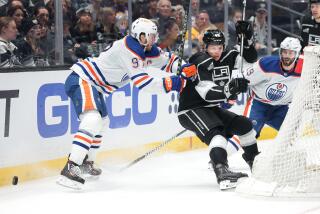Fiscal Play Is Key for Kings
Steve Duchesne taught the class.
The tuition was $4.25 million.
When Duchesne wasn’t the final piece of a Kings’ puzzle that defies completion, 33 years into the process, they settled his four-year, $11-million contract in March 1999.
He was richer.
They were wiser, after paying more than $1 million for each of his four goals.
“I’m not convinced that 35-year-old guys are the missing ingredient for this team,” says Tim Leiweke, the King president. “In fact, I’m certain it’s not the way to build an organization. We will not base our existence on 35-year-old players looking for a retirement contract. We won’t do that anymore.”
Leiweke grows heated and hyperbolic--Duchesne was 33 when he was signed--about building an NHL team that can compete for a playoff spot while not breaking the bank. It’s still theory with the Kings, whose playoff history has been hills and valleys, but few peaks, and whose economic history has included two previous owners jailed because of fiscal difficulty.
After the Duchesne experiment, the Kings became committed to making sense of a financial picture that has made NHL teams the kind of investment people make just before they buy ocean-front property in Kansas.
“He made us smarter,” says Kevin Gilmore, King assistant general manager and the man charged with keeping the player-salary boat afloat. “When we signed Steve Duchesne, everyone in this organization . . . and a lot of people outside the organization, thought it was a very smart move.”
Now the smart move, sometimes, is no move at all.
When he was trying to find a team to take 27-year-old concussion-ridden center Eric Lindros off his hands, Philadelphia General Manager Bob Clarke merely picked up a copy of Forbes magazine, read where King owner Philip Anschutz is worth about $11 billion and added them to a short list of teams with the wherewithal to make a deal.
Less than a week later, Philadelphia beat a deadline by renewing Lindros at $8.5 million, his salary for last season, to keep from losing him without compensation.
That offer gave Dave Taylor, the Kings’ senior vice president and general manager, his own headache.
“I did have a chance to speak with [Lindros], but that was before the qualifying offer,” Taylor said. “I talked to him and he appreciated our interest. . . . Along with the injury and what you would have to give up to get him in trade, [the $8.5 million salary] is a factor that has to be considered by any team.”
The Kings are not interested in Lindros or anybody else at $8.5 million, or anything close to it, something to think about when Rob Blake and Luc Robitaille can become unrestricted free agents next summer.
The Kings’ summer has been spent signing free-agent defenseman Mathieu Schneider to a one-year, $2-million contract and winger Stu Grimson to a one-year, $500,000 deal.
They also have signed European defensemen Andreas Lilja and Lubomir Visnovsky, who were drafted in June, and Tomas Vlasak, a Czech winger who had been playing in Europe, though he was drafted by the Kings in 1993.
This from a team whose revenue went up about $20 million when it moved from the Forum to Staples Center, one whose season-ticket prices just increased 8%.
But wait.
The move to a new building meant the Kings, who require about $60 million a year to run, fell $5 million short of that. A season earlier, the shortfall had been $21 million.
“This is a business,” Leiweke says. “This isn’t a charity. At the end of the day, this is not a not-for-profit foundation. Mr. Anschutz has a not-for-profit foundation that gives hundreds of millions of dollars to worthy causes around the country.
“This is a stand-alone business that, by the way, has never made money and did not last year. We got a lot closer. Last year is the best we’ve had since records were kept, which is not that long ago.”
Instead of going after free agents Gary Roberts and Mark Messier, the Kings are trying to grow their own talent and watch the purse in the process. From a $27-million player payroll two years ago, they added Ziggy Palffy’s $5 million and Bryan Smolinski’s $1.7 million and went to about $34 million last season. They will be at $36-36.5 million in 2000-2001.
That will be close to the top 10 in the NHL, whose teams are also slowing salary escalation.
“We’ve only signed two free agents, but we’ve signed a couple of our own players, and we spent some money signing two college free agents at the end of last season, [Steve] Reinprecht and [Michael] Pudlick . . . and we signed both of the European defensemen we drafted this year,” says Taylor. “So there could be four or five new faces, even if we don’t do anything [in a trade] before the season.”
Actually, the number is higher when you balance the team that begins training camp today in El Segundo with the one that went to camp last September.
Wingers Nelson Emerson and Kelly Buchberger were obtained in the Donald Audette trade, and center Bob Corkum was signed as a free agent last year. Defenseman Jere Karalahti came to town from Finland in December.
You can lump all of their salaries and you wouldn’t get $8.5 million.
Cheap?
No, Leiweke says. Smart.
“[Anschutz] lets us run this team as we see fit,” Leiweke says. “If I wanted to go to Phil tomorrow and tell him I want to jump into the free-agent market, he . . . knows that’s not the way to do it, but he would let me do it. . . .
“But [Taylor] has taken us on a different course. These two college kids [Pudlick and Reinprecht] we signed, that’s the way to do it. These kids are young. They’re 23, 24 years old. In addition to ‘Little Blakie’ [Jason Blake], that’s the way to go. These kids could turn out to be decent players. They’re not going to be superstars, probably. Or maybe they surprise us and turn out that way, but either way they’re going to be playing in the league a long time and that’s the way you invest your money.”
It’s all part of a five-year plan hatched in the summer after the Duchesne debacle that has as its goal making the Kings a playoff team every season, while losing as little money as possible.
Not making money, mind you. Just not losing as much.
“The fact is, the best we’re probably ever going to do here is break even anyway,” Leiweke says.
“But just because Mr. Anschutz has a reasonable basis of assets doesn’t mean we go stupid on how we build this team. New York went stupid and, guess what, we’re a better team than they are.”
The well-heeled Rangers are another topic that heats up Leiweke. They spent close to $60 million in player salaries last season--including more than $20 million in salaries for free-agent acquisitions--and finished out of the playoffs, much to his delight.
“We’ve got better depth in our organization than they do,” he crows. “We have to make sure there is a separation between resources and stupidity. Resources do not bring instant knowledge. Resources bring opportunity.”
In the Kings’ case, resources bring the $400-million Staples Center to grow more resources. They also bring the $24-million HealthSouth Training Center in El Segundo.
They bring money for scouting, particularly in Europe, where prospects usually cost less than Canadian juniors.
But increased resources will not bring high-priced free agents with long-term contracts.
“Of all the unrestricted free agents who have signed contracts in recent years, have the top-end guys made their teams better?” Gilmore says. “You look at it. I can think of a couple of top free-agent guys who have signed in recent years who have made their teams much better.
“Steve Thomas helped the Maple Leafs. Freddie Olausson really helped Anaheim. . . . But they were guys who signed for dollar terms that maybe kept them hungry.”
Instead, the Kings have opted to use free agents to address short-term needs. Grimson is a 35-year-old enforcer, brought in when the Kings lost Steve McKenna in the expansion draft. Schneider is a 31-year-old scoring defenseman, signed after the Kings lost Garry Galley to free agency and Sean O’Donnell to expansion.
They are Kings until their replacements can be grown in Lowell of the AHL this season, then Manchester, which the Kings will own next season and Gilmore will operate.
Ahead lies Year II of the five-year plan.
“We have doubled our payroll in the past four years,” Leiweke says. “We have not doubled ticket prices. The additional revenue created by Staples Center has taken a $20-million-plus debt that we accumulated on an annual basis, and reduced it to single digits. We’re getting to a point where this thing is beginning to make sense.
” . . . You go around the league and there are lot of teams pointing to the Kings and saying, ‘Those guys are doing it the right way.’ ”
Actually, most of the league is pointing to New Jersey, which won the Stanley Cup with a team that was largely home-grown.
But the Devils are being sold and one of the new owners is Yankee boss George Steinbrenner, a scary thought.
Montreal is for sale, to the NHL an even scarier thought.
Leiweke, Taylor and Anschutz figure the stable teams will be those run like a business.
“We are going to make a commitment,” Leiweke says. “We can spend more money than anybody. We’re in the second-largest market in the country. If we wanted to lose money, hell, we could be the biggest, baddest beast on the block. . . . [But] we owe an obligation to the sport. That obligation is to prove we can be successful in running a franchise on and off the ice. That’s the best thing that can happen to hockey and there are more teams dedicated to that than ever before.”
*
A year ago, Andy Murray oversaw his first practice with the Kings, knowing more then about the team than he does now.
Coaching a 94-point season, the Kings’ most successful in years, provided insight, but mainly it--and what has transpired since--opened eyes to some holes in the Kings’ lineup. Today, when they repair to El Segundo to begin training camp, the Kings will start seeing whether those holes have been filled.
“We almost have to do more evaluation this year than last,” Murray said. “That’s because there is more competition for positions. Last year we had a pretty good idea of what we had when we went to camp.”
The line of Robitaille, Jozef Stumpel and Palffy, which accounted for 198 points, is no more. Robitaille moves to a line with Bryan Smolinski and Glen Murray, and rookie Vlasak, a Czech, joins Stumpel and Palffy, two Slovakians.
Or rather, he will once Stumpel is signed. The Kings’ center is the lone holdout going into training camp, and there seems to be little movement in their positions.
(BEGIN TEXT OF INFOBOX / INFOGRAPHIC)
Training Camp
* Runs: Today through Oct. 4.
* First exhibition: at Phoenix, Sept. 14.
* Season opens: at Washington, Oct. 6.
* Last season: 39-31-12-4, 94 points (2nd in Pacific Division, 5th in Western Conference).
More to Read
Go beyond the scoreboard
Get the latest on L.A.'s teams in the daily Sports Report newsletter.
You may occasionally receive promotional content from the Los Angeles Times.






